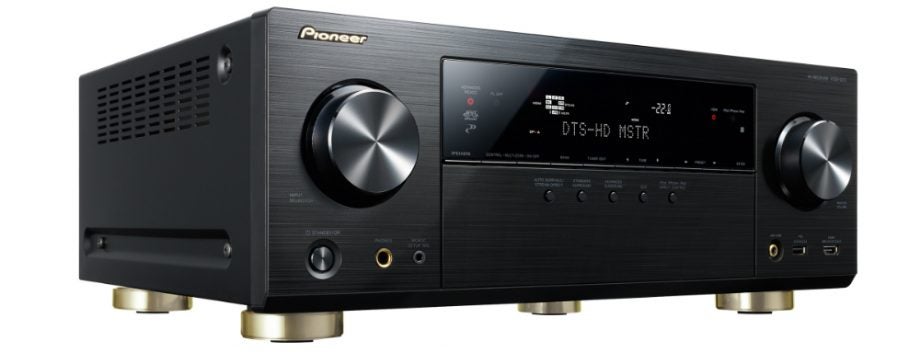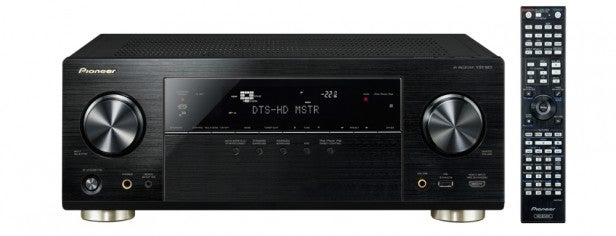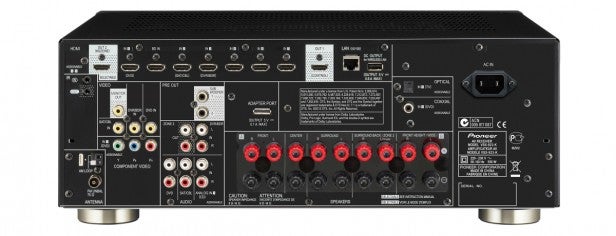Pioneer VSX-923 Review
Pioneer VSX-923
An affordable yet feature-packed AV receiver.

Sections
- Page 1 Pioneer VSX-923 Review
- Page 2 Features Review
- Page 3 Performance, Setup and Verdict Review
Verdict
Pros
- Crisp, entertaining sound
- Wide range of connectivity
- Eight HDMI inputs
Cons
- Sound lacks aggression compared with rivals
- Confusing remote
- No built-in Bluetooth or Wi-Fi
Key Specifications
- Review Price: £449.99
- 7.2-channel AV receiver
- AirPlay and HTC Connect
- Internet radio and DLNA music streaming
- 4K video upscaling and passthrough
- Eight 3D-ready HDMI inputs
- Dolby Pro Logic IIz and DTS Neo:X
What is the Pioneer VSX-923?
The Pioneer VSX-923 is a 7.2-channel AV receiver from Pioneer’s affordable VSX series, boasting a generous feature list with several new additions for 2013 – some of which derive from the high-end SC range.

It’s one of six models in the range, sitting below the top-end VSX-1123 (£549.99) but above the VSX-828 (£349.99), VSX-528 (£299.99), VSX-423 (£249.99) and entry-level VSX-323 (£199.99). That places it in the fiercely competitive sub-£500 market alongside the Onkyo TX-NR626 and new models from Yamaha and Denon.
Pioneer VSX-923 – Design
The Pioneer VSX-923 is styled with the company’s usual panache, which means an elegant, understated black finish and huge dials on the front for volume and input selection. It’s not the sort of product that’ll jump out at you – AV receivers rarely are – but it won’t stick out like a sore thumb either. This is a great-looking amp, and although the fascia is a little plasticky to the touch, build quality is generally robust – the dials, for example, turn smoothly and firmly.
Its front panel is blissfully free from clutter, and what buttons there are blend discreetly into the black finish. These include controls to toggle through the various sound modes and tune into radio stations.
The Pioneer VSX-923’s LED panel is nice and big, with enough room to display audio format names and volume. It also shows you selected sound modes and a small diagram of the connected speakers, while red lights let you know when an iPod or HDMI device is active.
Pioneer VSX-923 – Connections
On the front panel you’ll find an HDMI input, which supports the latest version of Mobile High-Definition Link (MHL v2.0). It provides an easy way of watching HD videos from Android smartphones on your TV – allowing you to control playback with the Pioneer’s remote and charge the device while you watch – but this new incarnation also supports 3D videos.

You also find a USB port designed for iPod, iPhone, iPad and USB drives, with a component video input for watching videos from Apple devices. There’s a headphone jack and a port for the MCACC auto setup mic.
On the back are seven more HDMI inputs – which trumps the six found on Onkyo’s TX-NR626 – and two outputs. You can use the second ‘HD Zone’ output to send a Full HD, 3D and even 4K signal to a separate room, either the same source as the main HDMI out or a different one. The outputs also support Audio Return Channel, which can receive sound from a compatible TV without the hassle of rigging up a separate cable.
Elsewhere the line-up covers most bases without going overboard. There are two digital inputs (one optical, one coaxial), four sets of analogue stereo inputs, a component video input, three composite video inputs and one monitor output.
Going a little more advanced, the Pioneer VSX-923 also has a Zone 2 analogue stereo output, two subwoofer pre-outs, an Ethernet port, a second USB port for Pioneer’s optional wireless LAN dongle, IR in/out and FM/AM aerial inputs.
Nine pairs of plastic speaker binding posts allow you to hook up front, centre, surround, surround back and front height/width speakers, although with seven channels you can’t have surround back and front height at the same time.

